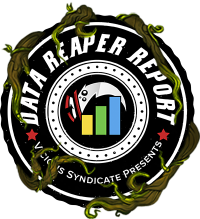
Welcome back to the Wild vS Data Reaper Report! We’re the experts from r/WildHearthstone, and we have partnered with Vicious Syndicate to create the Wild Data Reaper Report. We will be contributing the write-ups and analysis for the report, backed up by the statistics that Vicious Syndicate has become famous for. The data presented in this article is based on 42,000 games.
The Patch 9.1.0 Nerfs have really shaken up the metagame, with Spreading Plague, Hex and Fiery War Axe’s costs all increased by 1 mana, Innervate only providing 1 extra mana, and Murloc Warleader losing the health buff from its aura. Two of the most powerful wild decks, Pirate Warrior and Jade Druid, decreased significantly in power level. Additional to the data collected from these balance changes, we have data on the giants decks that started to gain traction just before the last report. This report will investigate the giants package in Hunter and Ramp Druid.
Quick Links
Class/Archetype Distribution | Matchup Winrates | vS Power Rankings | Class Analysis & Decklists | How to Contribute | Credits
Class/Archetype Distribution
[TABS_PRO id=10598]
Class Distribution Discussion
With the effective loss of vital cards from the two powerhouse decks of Pirate Warrior and Jade Druid, the meta went into a flux. First and foremost, Priest’s rise in play continued, with the class sitting at the top of the meta with over 20% representation, and over 25% from R5-Legend.
Pirate Warrior is no longer the dominant force in the Wild metagame – its former foil, Reno Priest, has taken its place. With a play rate of 16% overall, and 18% from R5 to Legend, this deck will characterize the Wild meta for the foreseeable future. Big Priest and Inner Fire Priest are also present, but less common. One interesting development over this month has been the play percentage of Priest at different rank brackets. For the past three reports, Priest’s play rate has inversely correlated with rank – now it’s the opposite.
Back from the dead is Hunter. Last expansion, Hunter was on the brink of breaking into wild, held back by Pirate Warrior and Reno Jackson. With Pirate Warrior licking its wounds, Midrange Hunter and Giants Hunter have been able to get a foothold in the meta. Overall, Midrange is more popular. From ranks 5 to Legend, the second most popular archetype is Giants Hunter, and below it is Deathrattle Hunter, which combines cheap Play Dead triggers and Hunter’s strong class deathrattles, as well as cheap neutrals such as Nerubian Egg and Mad Scientist to fight for early board presence.
Mage, as always, is a diverse class. With the lack of a supreme aggressive deck due to the decline of Pirate Warrior, Tempo Mage has come to the front of the class. The rest of the class’ archetypes have stayed approximately where they were last report, with Reno Mage and Exodia Mage being solid ~2.5% decks.
Paladin leads the meta in competitive diversity, with 5 archetypes representing over 1% of the meta each. Midrange Paladin remains the most dominant, and nerfs to its two biggest competitors, Pirate Warrior and Jade Druid, mean there may never have been a better time to make little dudes big again. Murloc, Control, Secret and Handbuff Paladin remain essentially at the same spot, seeing no significant increase or decrease in play.
Druid has shifted in its representation. Jade Druid used to have a significant lead on Token Druid. Now both see similar rates of play across all ranks, and from Rank 5 onwards, Token Druid skyrockets in play, with about twice as many pilots as Jade. Ramp Druid has largely adopted the Giants package, with a minimal amount of players running Astral or Big variants.
Warlock has also begun to swing back from last report, with Renolock becoming the second most popular deck behind Reno Priest’s monstrous share. Like all aggressive decks, Zoo has seen an uptick in play post-FWA nerf. While Zoolock has yet to really show in our data, it’s poised to see much more play going forward.
Shaman, at the moment, is only comprised of aggressive variants due to Reno Priest’s dominance in the meta. Aggro Shaman has become the SMOrc flavour du jour and is one of the fastest decks in the game. Token and Murloc Shaman make up the rest of Shaman’s numbers, filling up the void that was left by Pirate Warrior’s decline. Aggro Shaman, however, remains the dominant archetype as we look at higher levels of play, where its representation increases.
Rogue, a class that has been struggling in Wild, has benefitted from the Pirate Warrior nerf as well, with Tempo Rogue becoming a prevalent archetype seemingly out of nowhere. This is most likely due to Pirate Warrior players finding a new home with the next best Pirate deck and the success Keleseth decks are having in Standard format. While an optimal list has not been discovered yet for Wild, this deck has potential to grow, as all of the aggressive decks are now fighting for supremacy on more even grounds.
How did the FWA change affect Warrior’s play rates? Pirate Warrior’s popularity has been slashed by more than 50%, dropping to a 6% meta share. It is no longer the deck to account for when building all other decks, as that spot has been completely taken over by Reno Priest. However, the deck is not dead, and is the second most popular archetype from rank 5 to legend. Control Warrior builds remain at around the same play percentage as last month.

[TABS_PRO id=10607]
Atop our power rankings is an archetype that was impacted by the Innervate change but seems to have shaken it off remarkably well: Aggro-Token Druid. It is the aggressive deck which fares best across the field, and seems like an extremely powerful deck to pilot considering it does fairly well in aggressive mirrors while still being able to pull off pre-turn 6 wins against Reno Priest. Tempo Rogue, similarly to Aggro Druid, is very effective at fighting for early board control, resulting in a strong matchup spread that has very few weaknesses.
Recruit Paladin can occasionally capitalize on aggressive starts, but that is not what makes it a powerful deck in this meta. The deck has enough early presence to contest against other aggressive decks, but what makes it stand out is its resilience to board clears. With some of the stronger builds now running two copies of Stand against Darkness, the deck essentially becomes a board refill machine, continuously threatening large amounts of damage through buff cards. This consistent pressure and ability to snowball out of control after surviving through a few waves of board clears, makes it a threat to any control deck out there.
Reno Priest is obviously a strong archetype which shapes the meta around it. However, using the deck to counter the meta may not be the best strategy, as the rest of the meta is doing the exact same thing, and it’s not easy to gain a large enough edge in mirror matchups. Get used to playing them!
Aggro Shaman and Zoo Warlock round up the rest of Tier 1 at higher levels of play. The challenge for every deck in the meta is to beat Reno Priest, and the game plan of these two decks is either to beat down the Priest until it’s dead, or just pressure it enough to force a Reno while having a board, and then killing it with post-Reno damage.
Class Analysis & Decklists
Druid | Hunter | Mage | Paladin | Priest | Rogue | Shaman | Warlock | Warrior
Spreading Plague has had its mana cost increased by one, and Innervate is now essentially the Coin. Many players believed that Jade Druid would be unaffected by these changes and that Aggro-Token Druid would be dead. It turns out this was far from the truth. In Wild, Jade Druid has fallen to the bottom of Tier 3 and Aggro-Token Druid is now the top deck to beat in Wild. In fact, Aggro-Token Druid’s win rate has increased since the last report!
The prolonged life of Aggro-Token Druid in Wild can be explained by Wild-specific cards such as Haunted Creeper and Jeeves. The most popular build of Aggro-Token Druid has also been teched with double Crazed Alchemists to improve its win rate against bad matchups such as Inner-Fire Priest, Reno Priest, and Reno Warlock. Being able to remove a Doomsayer on Turn 2 or eliminate the threat of a Deathlord can be a huge tempo swing. Crazed Alchemist can also be used in conjunction with Crypt Lord and Savage Roar for insane bursts for lethal. Vicious Fledging is no longer popular in Aggro-Token Druid, since it was only truly Wild playable ahead of curve. It should be noted that Egg Druid builds were unaffected by the Innervate change since these lists did not run the card.
Jade Druid has taken a big hit because of the change to Innervate. To account for this change many Jade Druid players have included additional Ramp like Pilfered Power or Mire Keeper. Although Spreading Plague is still a great card at six mana, the Innervate change has made the deck exceptionally weak to aggressive decks in Wild. Giants Druid also faces the same problem with the ability to cheat out an early Naga Sea Witch made more difficult. Without tools to manage its inconsistency, it lands itself in a weak spot in the meta, dropping all the way down to Tier 4.
Hunter is in an awkward spot, yet again. Despite having 3 semi-viable archetypes, its unfavorable matchups across the board against the best decks make Hunter a dicey proposition.
Giants Hunter sits on top of the pack. As a giants deck, it loses to most popular aggro decks, which keeps it from being better than it is. Most of the build is fairly standard, with the giants package containing Molten, Mountain, and Sea giants, with Clockwork giants also being reasonably popular.
Deathrattle hunter is the second best hunter deck; it feels like it loses to itself more than anything else. With the right hand, it’s a scary proposition, making large boards early that the opponent can’t easily clear. It can also draw upside down and not be able to play anything meaningful before turn 4, a death sentence on ladder. Stitched Tracker helps address this inconsistency, but its draw-smoothing is dwarfed by the scale of the problem.
The traditional Midrange Hunter is currently the worst of the bunch, mostly due to its inflexibility, and a lack of meaningful synergy. It gets outpaced by other midrange decks such as Recruit Paladin, and outvalued by slower decks. Having no real comeback mechanics and matching up poorly against almost all of Priest’s removal make Midrange Hunter’s life tougher.
Mage has reached quite a stagnant point with its archetypes. Many of the decklists have barely changed with the post-nerf meta. The main archetypes of Mage that are still seeing a regular amount of play are Tempo, Reno, and Exodia Mage.
Exodia Mage drastically declined in playability due to Jade Druid’s recent nerfs. Exodia Mage has mainly Priest to “counter”, which isn’t even a strongly favored matchup. With wider and more aggressive decks in the meta, thanks to the Spreading Plague nerf, Exodia Mage becomes weaker. For these reasons, Exodia Mage should only be used when you can target a specific meta.
Reno Mage is a very solid control deck that has a lot of flexibility against a variety of decks. With Frost Lich Jaina, Reno Mage has the potential to close out games from the accumulation of serious card advantage in the late game. Druid’s nerf has benefitted Reno Mage tremendously since it’s one of the deck’s worst matchups. It also can perform well against current builds of Reno Priest with Ice Block into Reno, but it is still unfavored against Reno Priest, as the Priest can often find their combo much faster than Reno Mage can apply pressure.
Tempo Mage has started to shine a little more in the meta with two different variations of the deck. One focuses more on secret synergies, while the other focuses on Flamewaker synergies to secure tempo. With the meta still relatively slow, Tempo Mage’s main weakness (aggressive decks: as they can easily play around secrets and clear low health minions) is lessened. Tempo Mage is able to develop secrets that protect their minions, allowing for a lot of cumulative face damage. The ability to negate midrange and control players the opportunity to come back or develop allows Tempo Mage to maintain a reasonable presence in the meta.
- Harain’s and ControlTheBoard’s Tempo Mage
- slizzle466’s Tempo Secret Mage
- Bananaramic’s Reno Mage
- Bananaramic’s Exodia Mage
Blizzard has answered the debate over whether Mid-Range Paladin should run Recruit synergy or Murloc synergy with a swift nerf to Murloc Warleader. As a result, the Murloc variant dropped to Tier 3 despite nerfs to other agressive decks. With the Murloc Warleader change, Murloc Paladin can’t snowball an early game advantage as effectively and is much more vulnerable to the large menu of board clears available in Wild.
Murloc Warleader isn’t completely dead though. With the recent popularity of Reno Priest, some have turned towards the Anyfin Package to burst the Reno Priest before they can develop their own burst damage. While this may have been effective at first, Reno Priests have very quickly focused on card draw, equalizing the advantage Anyfin Paladin once had. With this note, we’ll continue to keep an eye out for this variant as the meta continues to develop.
Being among the strongest KFT decks unaffected by the nerfs, Recruit Paladin has made a valiant return to Tier 1 at all levels of play. Recruit Paladin struggled against the Jade Druid lists prior to the Innervate and Spreading Plague changes. While these nerfs certainly help the archetype rise in the ranks, Recruit Paladin has been kept in check by the newest arrivals, Tempo Rogue and Zoo Warlock. These decks are often just a step ahead of Recruit Paladin’s game plan. Tempo Rogue and Zoo Warlock, along with aggressive Druids, can overwhelm Recruit Paladin with better and faster board floods. If these tempo decks continue to rise, Recruit Paladin could find its power level dropping once again.
Secret Paladin offers an enticing option for Paladin to combat the new Tempo decks. Fighting fire with fire, or in this case tempo with tempo, Secret Paladin may prove to be the best archetype for Paladin moving forward even though its play rate is quite low. In this report, we tentatively place Secret Paladin in Tier 1, as it seems to be a very promising performer based on its small sample size.
- Haydumb’s Anti-Priest Midrange Paladin
- Haydumb’s Midrange Paladin
- Toymachine’s Murloc Paladin
- Awedragon’s Anyfin Paladin
- Chai’s Secret Paladin
- Schmiddy’s Control Paladin
Priest has emerged as the class to beat in Wild, with three successful archetypes: Reno Priest, Big Priest and Inner Fire Priest. Dragon Priest is also a likely viable deck, but has not seen very much play in the past month, but this could change if a refined list can be designed for this meta.
Reno Priest has become one of the most consistent and effective decks in the current meta, with Knights of the Frozen Throne having given it a powerful Hero card in Shadowreaper Anduin that synergizes incredibly well with Raza the Chained. Whereas previously Priest had no access to any usable burst damage, the addition of a repeated Shadowform has meant that Priest is far more able to become the aggressor in control mirrors. The package itself is so versatile that a few different builds have emerged, using cards such as Spawn of Shadows, Velen, a combination of the two, and even the often mocked Recruiter (consensus opinion appear to be that it’s a win-more card) to provide the setup for a lethal OTK, as well as the more value oriented N’Zoth package. The deck is a Tier 1 powerhouse at all levels of play, sporting one of the highest win rates in the game despite having the entire meta attempting to counter it. Several players, such as Capilano and Sipiwi94, shot to top legend using their own versions of the deck. The most recent balance changes took power away from two of its most common difficult matchups in Pirate Warrior and Murloc Paladin, while weakening Jade Druid lists which were also troublesome to Reno Priest. In the KFT Wild meta, if your deck is not designed with Reno Priest in mind, it is unlikely to succeed.
Big Priest is without a doubt one of the most divisive decks on ladder at the moment. While its win rate is not extraordinary by any means, its good matchup with Reno Priest makes it a particularly popular deck, especially at higher levels of play. The recent printing of Eternal Servitude, Shadow Essence, and Obsidian Statue have allowed for incredible tempo swings in the mid-game that very few decks can consistently stand up to. The constant pressure of well-statted valuable legendaries being resurrected on the cheap can overwhelm the mid-range and control decks in the meta, since it allows Big Priest to use their strong removal package to protect their newly-summoned minions . The deck is built almost uniformly, being made up of removal, the resurrect package, Barnes and big minions. The current list forgoes Excavated Evil to include Sneed’s Old Shredder and Shadowreaper Anduin. With Pirate Warrior seeing half the play it used to, Big Priest is a much safer choice for laddering.
The Inner Fire Combo Priest first became a monster during the Un’Goro meta and has seen relatively low play since Knights of the Frozen Throne, potentially because it doesn’t use many, if any, new cards. It remains, however, one of a few decks that can prey on Reno Priest and slower Druids with its incredible burst potential. There are quite a few ways to build Combo Priest, with lists using a combination of Light of the Naaru, Zombie Chow, Tar Creeper, Auchenai Soul Priest, and Lyra the Sunshard as interchangeable slots. Similarly to other Priest decks, it benefits from the weakening of Pirate Warrior. Control Shaman, historically its worst matchup, has also been almost nonexistent since Knights of the Frozen Throne launched, as it largely folds to Reno Priest.
For the first time in Wild’s history, Rogue has found itself sporting a Tier 1 deck! We certainly didn’t expect to be saying this considering Rogue’s rather dismal statistics in previous reports. However, the recent nerfs did a lot to promote a meta suited for Rogue. Pirate Warrior’s fall from grace lifted a heavy burden from every Rogue player, as that all-in face archetype was among its worst matchups, regardless of Rogue archetype. Furthermore, the Druid nerfs not only took away a fairly difficult matchup for Rogues, but gave Priests a huge amount of ground to claim. The resulting perception of a control-dominated metagame has driven players away from tech cards such as Golakka Crawler and Oozes that hate on many Rogue lists. Instead, tech slots are being replaced with powerful (and often expensive) trumps against board wipes & burst heals, giving Rogues more room to breathe as they attempt to tempo out.
Speaking of tempo makes for a clean segway into Rogue’s dominating new archetype: Tempo Rogue. While this archetype is also known as Keleseth Rogue in Standard, that title wouldn’t quite cover the flexibility this deck has already shown in its first month in Wild. Prince Keleseth has found plenty of success in Wild Rogue decks, to be sure. However, some prefer to eschew the Prince’s power in order to play the consistent 2-ofs of Ship’s Cannon and Eviscerate. Whatever the flavor, all of these lists pack a high number of pirates and a gamut of midgame minions focused on board control or card advantage: cards such as Southsea Captain, Argent Horserider, Piloted Shredder, Loatheb, Azure Drake, and Vilespine Slayer. These clog up the board and apply pressure until the Rogue can set up lethal with oppressive closers like Bonemare or Leeroy coupled with Cold Blood or even Tinker’s Sharpsword Oil. While these lists do have the unique Rogue quality of having absurd “highroll” combinations in their opening hands, they also suffer from the usual Rogue problems. Other aggressive decks can simply out-aggro the Rogue deck by getting on the board earlier. Going wide in particular is extremely effective against Tempo Rogue, as there are no tools in the Rogue’s arsenal to take back a flooded board outside of narrow hate cards such as Dark Iron Skulker – this is indicated in the weakness to Aggro Druid and aggressive Shaman archetypes. Recruit Paladin is an exception to this, largely because the Paladin decks also has no consistent way to come back against a Tempo Rogue that takes the board, and Rogues tend to make explosive plays a turn or two before the Paladin can land its Recruit payoff cards.
Before the lean, mean tempo archetype began making waves in Wild, another classic Rogue deck took a player on EU all the way to Rank 1 Legend in September: Oil Rogue. As Priests quickly filled the Druid and Warrior-shaped holes in the adjusting metagame, Kohai generated a list seemingly custom built to beat Anduin. Like traditional Miracle lists, but with less emphasis on the Auctioneer portion of the strategy, these decks are midgame tempo decks that aim to chip away at the opponent until they can set up game-ending swings with Tinker’s Sharpsword Oil. The aforementioned lack of weapon hate was a huge part in enabling this archetype to shine, on top of the metagame slowing down in general. That said, these lists have fallen off drastically since the emergence of the faster Tempo Rogue lists. While Oil Rogue is stronger against Control in general, these few matchups come at the cost of a worse win rate against every single aggressive deck in the format. The Kohai lists simply sacrifice too much early game with so many powerful aggressive decks, especially since they’re unfavored against the faster Rogue decks, too. For those looking to beat Priests on ladder, feel free to jam Oil or Miracle; but be ready to take some licks from more aggressive decks in the process.
- Awedragon’s Keleseth Tempo Rogue
- Haydumb’s Keleseth Tempo Rogue
- Holt’s Pirate Oil Tempo Rogue
- Kohai’s Oil Miracle Rogue
- Graveyardsmash’s Classic Miracle Rogue
- Bananaramic’s Mill Rogue
- DannyDonuts’ Jade N’Zoth Rogue
The most recent set of balance changes took away two entire classes’ abilities to deal with the classic Aggro Shaman opener of Tunnel Trogg into Totem Golem. This led many to speculate that Aggro Shaman would rise up and become the premiere aggressive deck in the format; however, most overlooked the possibility of aggro decks with poor Pirate Warrior matchups flourishing as well. Tempo Rogue took the meta by surprise, popping up post nerf and boasting the second highest win rate among all decks. Both Tempo Rogue and Aggro-Token Druid rank above Aggro Shaman in the power rankings because they fare better against Reno Priest. Aggro Shaman struggles to fight through Reno Priest’s powerful defensive tools and board clears; given that Reno Priest currently makes up nearly a fifth of the R5+ ladder, Aggro Shaman cannot be the dominant aggressive deck in the format and finds itself ranked mid tier 1. As the meta shifts and becomes harsher towards Reno Priests, Aggro Shaman could definitely find itself on top, it is still an excellent choice for laddering and many players achieved high legend finishes with it in September.
Token Shaman has remained strong against a variety of decks, including some of the newer decks that have risen up in popularity post-nerf, increasing its power level to the top of tier 2. Players should definitely queue up their Token Shaman lists whenever they are seeing a bubble of Token Druids or any Rogue or Warrior archetypes. What prevents Token Shaman from seeing the light of Tier 1 is, again, Reno Priest. Anduin players are able to freely cycle with the lack of explosive pressure from the Shaman so they are sure to hit at least 1 of the many AoE options available to them.
Murloc Shaman is seeing a lot of play mostly at lower ranks (Rank 20-Rank 10). The snowball effect that all murloc decks require took a major hit with the change to Murloc Warleader’s aura. Murloc Shaman is cheap and can do well at lower skill levels but don’t expect to climb much higher with any consistency.
Control and Malygos Shaman both used to be highly competitive decks in the wild meta as little as 3 months ago. Control Shaman struggles from the lack of cycle and pressure to keep up with Reno Priest, and the nerf to hex doesn’t help either. Malygos Shaman, however, can cycle quickly enough to assemble the combo before Reno Priest assembles its own. In addition, Malygos shaman fares well against most of the aggressive decks that are present on ladder. In short, Malygos Shaman takes what made N’Zoth Control Shaman great during Journey to Un’Goro and adjusts to account for the rampant threat of Reno Priest.
- SamAnthony’s Aggro Shaman
- Masinc’s Doomhammer Aggro Shaman
- Xixo’s Token Shaman
- Poach’s Control Shaman
- Poach’s Malygos Shaman
- Murloc Shaman
Renolock has improved since the balance changes, yet continues to tread water in the middle of Tier 3. The Druid nerfs have slowed down Jade Druid enough that it’s no longer oppressing Renolock like it once did. The abundance of AOE’s at Renolock’s disposal has also allowed for a favorable matchup against the best performing meta deck, Aggro Druid. The biggest problem, however, is the abundance of Reno Priests and Big Priests in the meta. Popular Reno Priest lists contain lots of draw along with spells to control the board in order to draw Raza the Chained along with Shadowreaper Anduin in time to burst you down with either Prophet Velen or Spawn of Shadows. In order for Renolock to have a fighting chance, it’s best to establish tempo and force Priest players to react. This is, so far, best done with Demon-centric cards such as Voidcaller, Kruul, and Bloodreaver Gul’dan. By trying to force Priests to exhaust their AOE and use their cheap spells, you can potentially set up a board that they are unable to answer. Hurryupidiot was able to finish top 20 legend using that style alongside the Renolock combo (Leeroy Jenkins + Faceless Manipulator + Power Overwhelming) to have both grindy and burst finishers.
A deck that has been struggling to free itself from the clutches of irrelevancy, Zoolock, with its demon package and Bloodreaver Gul’dan, has emerged as a new challenger to top tier wild decks. The new Zoolock, which is built based off of its standard counterpart, runs the usual cheap minions, buffs, demons, pirates and Prince Keleseth. Bloodreaver Gul’dan enables a big late game swing turn that can close games out.
Zoo aims to flood the board early with possibly buffed minions from Keleseth and then curves out nicely in the mid-game. It looks to play Bloodreaver Gul’dan when the opponent has exhausted a lot of their removal. With control decks becoming greedier due to the the complacency introduced by the notable drop in the play-rate of Pirate Warrior, a Zoolock that has elements of a midrange deck, can thrive. Quite a few top legend players have used the archetype to climb to the top of the legend ladder this season.
There is also a very interesting demon based discard Zoolock that is surfacing on ladder. It causes problems for Priests with 4 attack minions such as Succubus and Wrathguard, and since this alternative approach has also been performing well on ladder, we’re featuring it.
With the nerf to Fiery War Axe, Warrior struggles for class identity. (♪who am I / 2/3/2 is gone!♪) While at one point, Pirate Warrior was able to police the greediness of the meta, the deck has become a ghost of its former self, unable to answer early game threats and take the board early as well as it used to. As a fairly good counter to greedy Reno Priests, losing some of the explosive power of this deck has permitted Priest to run rampant, having to face much less of an aggressive presence on ladder. The Reno Priest vs. Pirate Warrior matchup has become much weaker for the Warrior, as Pirate Warrior’s explosive starts are far less consistent, giving the Priest more time to stall and stabilize. Reno is a big factor in these matchups; where you could once kill your opponent before they were able to play Reno on turn six, now you get them in kill range around turns 7-8, which gives the opponent a greater chance to draw Reno and win the game. Many players have tried to adapt different versions of this deck to find the “optimal” new build so there are a few variations of Pirate Warrior circulating the ladder. Two of the notable builds are ones that include Keleseth, which requires cutting ship’s cannon, arguably the most powerful card in the deck. Others have experimented using cursed blade as an early weapon, which has done surprisingly well in aggro-light metas. However, its drawback against other aggressive decks, particularly Aggro Shaman, is debilitating. Others have slotted in King’s Defender, Fiery War Axe’s now strictly better cousin.
With the changes to Fiery War Axe, Control Warrior got hit pretty hard as well. It lost its best tool to contest the early game, making it so you have to rely on your AoE removal and slower weapons to take back board control from faster decks. In the slower matchups, Control Warrior also struggles, as it gets easily outvalued. With the rise of cycle-heavy Reno Priest lists, Control Warrior becomes an interesting option. With the build showcased, you are able to Out-Armor the Reno Priest and fatigue them. One of your top priorities is to make sure you fit in an armor up every turn you can, which is even more important with Tank Up. Every hero power you use is one of their hero powers nullified. However, if a Reno Priest is greedy, the matchup becomes much harder to win.
- Cursed Blade Pirate Warrior
- Keleseth Pirate Warrior
- DannyDonuts Pirate Warrior
- Scorpion’s N’Zoth Control Warrior
Meta Breaker
With Reno Priest becoming the new face of Wild and aggressive tempo decks filling out the rest of Tier 1, the Wild metagame has become quite polarized. With this in mind, our wild Meta Breaker of the Month is Zoo Warlock. It is currently in the midst of a massive spike in representation at higher levels of play. The midrange Demon Zoo lists with Voidcaller and Bloodreaver Gul’Dan (sometimes ft. Mal’Ganis) have the grinding power to keep up with Reno Priest’s removal, and the overstatted minions (especially post-Keleseth) can enable it to control the board against other fast decks.
Another discard-themed version of the deck designed by Atralb is seeing more play as well. It runs a larger number of 4-attack minions. Combining Malchezar’s Imp with Bloodfury Potion is a recipe for disaster as far as Anduin and Tyrande are concerned. In either list, Prince Keleseth isn’t necessary to win games, but gives the deck another angle of attack.
Our Data Reaper Project, including the Data Reaper Live (Beta) has 4,500 active contributors. Without them, this project would not be possible, so we’d like to thank all of our contributors for their help. If you’d like to sign up to share your Standard or Wild game data, click the banner below.
Contributors
Here are all the people that participated in bringing you this edition of the [Wild] vS Data Reaper Report:



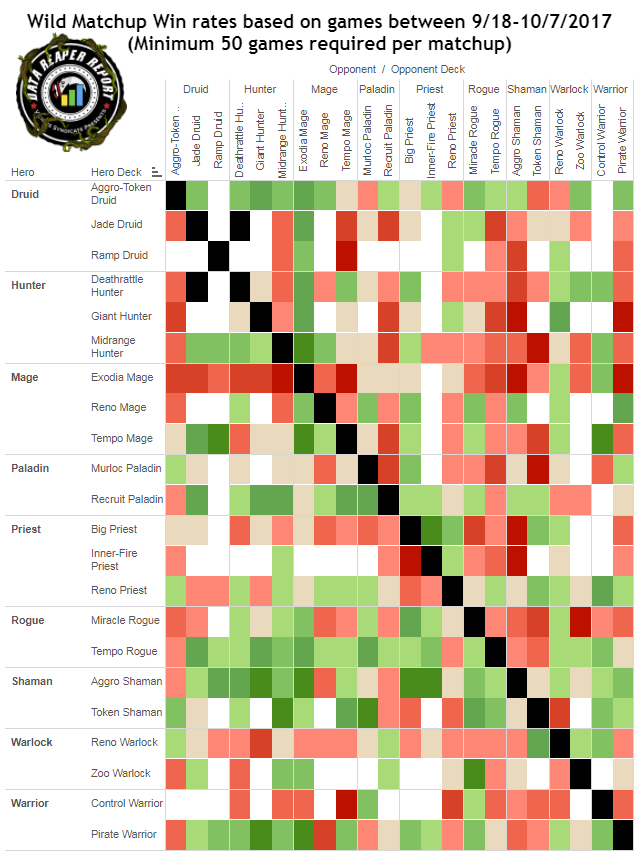










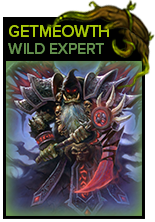

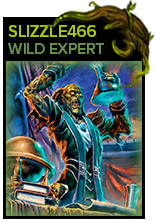
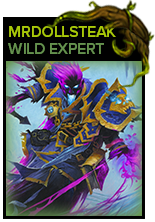
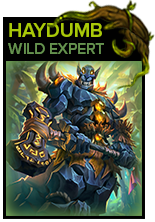
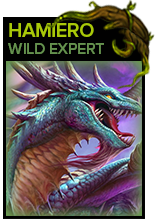
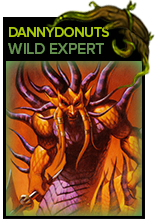
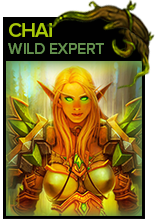
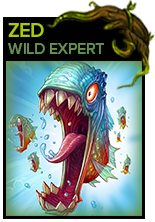

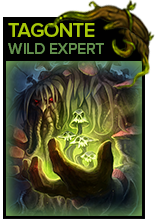
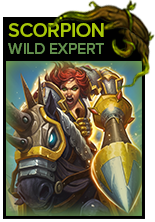
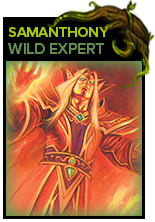
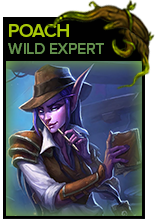



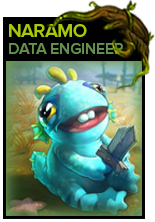

How on earth is Reno Priest even against Exodia Mage? Excluding unlikely scenarios like Rats pulling Antonidas or Priest getting Ice Block that MU is awful for Priest… It should be like 80/20 for Mage not 50/50 same goes for Jade Druid,not as favoured as Priest but not even remotely unfavourable for Mage…
Exodia Mage without the quest or cabalist tome? wtf
This part of the Aggro Shaman blurb confuses me: Both Tempo Rogue and Aggro-Token Druid rank above Aggro Shaman in the power rankings because they fare better against Reno Priest.
Aggro Shaman win rate vs Reno Priest: 47.7%
Tempo Rogue: 45%
Aggro-Token Druid: 47.5%
In other words, both decks mentioned have worse win rates vs Reno Priest. But also, Shaman is listed above Tempo Rogue in the power rankings (rather than below as stated)
You’re probably right. It’s just weird to see Exodia Mage with no quest. You forget you don’t need a second turn when Emperor enables everything to be played in one turn.
you can otk with just one tick on 4 of the cards
The Exodia Mage list doesn’t have the Quest included. Not sure if that is an error or what, as all the cards seem rather mandatory. Maybe Bloodmage was cut?
With Emperor Thaurissan, I dont think quest is necessary?
Quest is unnecessary in Wild. You’re looking to get a Thaurissan hit on 4/5 combo pieces.